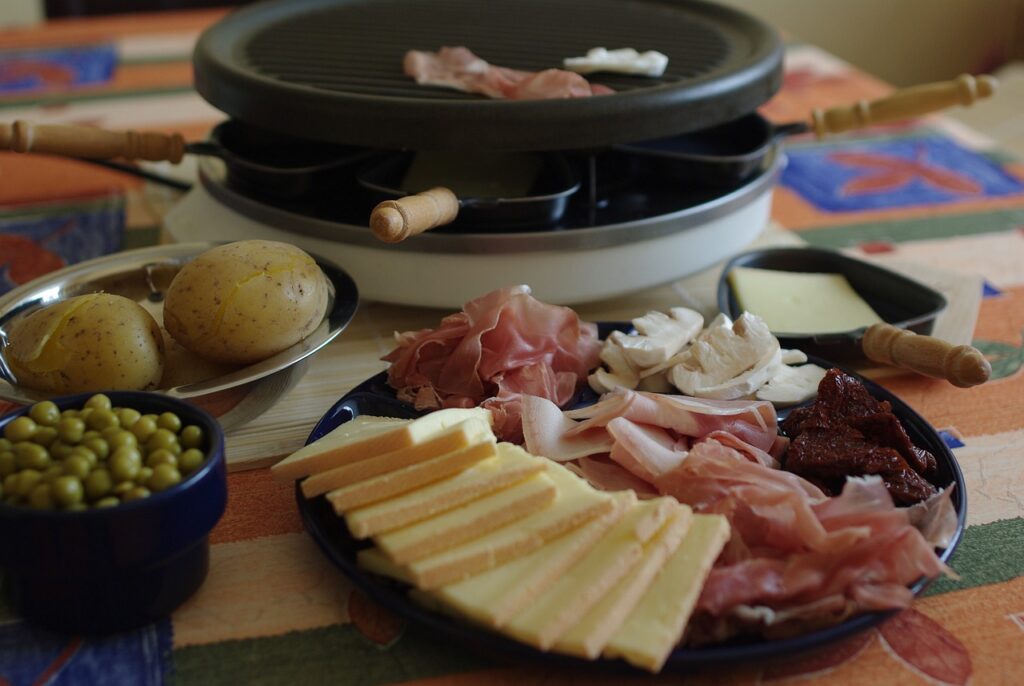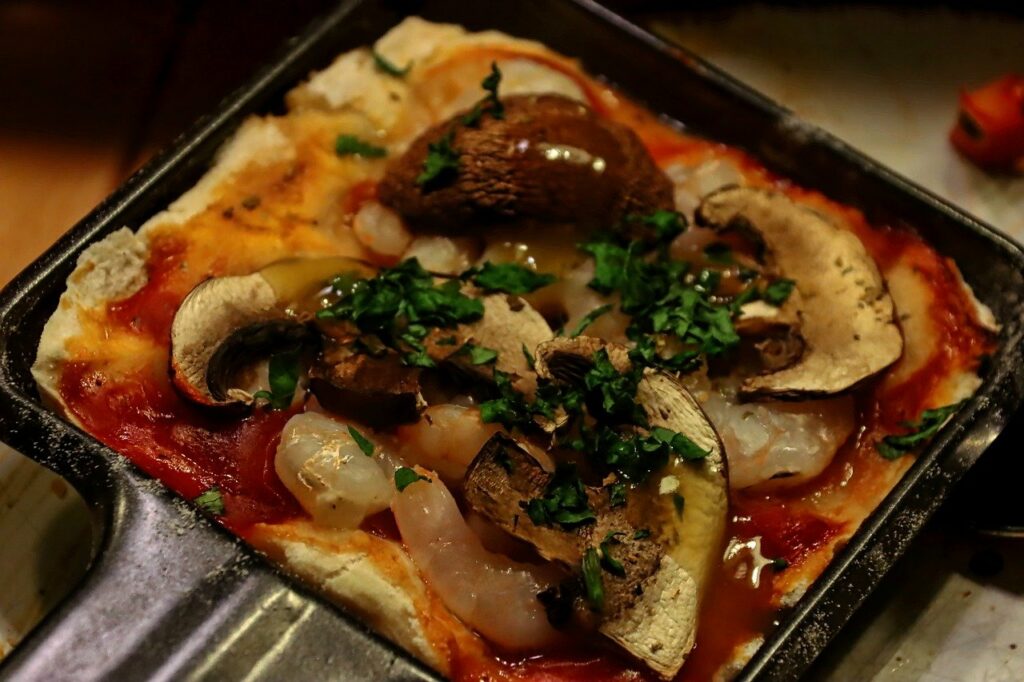Oh, raclette… Silver medallist on the podium of France’s favorite dishes, this gastronomic marvel never ceases to spoil the taste buds of the most discerning gourmets. A traditional dish for winter, autumn and all year round for the true lovers, raclette reveals all its secrets in this article from the cheese French experts at Paroles de Fromagers.
Let’s find out all you need to know about the famous raclette, so beloved by the French people!
What is Raclette is France?

Raclette is an emblematic dish of the mountainous regions of Switzerland and France, whose origins go back several centuries. This culinary tradition is said to have originated in the Swiss Alps, where shepherds, during their long periods spent at altitude, invented this convivial dish to warm up and satiate themselves.
The word “raclette” is not actually the name of a cheese. In fact, it comes from the French verb “racler”, referring to the action of scraping melted cheese off accompaniments. Raclette” therefore refers more to the spatula used to scrape the cheese.
Over time, raclette has become a celebration of conviviality and mountain gastronomy, bringing family and friends together around a table laden with delicacies.
How do the Swiss or French mountain people eat raclette?
The traditional Swiss recipe is a simple but delicious feast, featuring the unique cheese that is the flagship product of the Alpine regions. To prepare a traditional raclette, start by choosing a good cheese, usually matured for several months to develop its aromas.
Serve with steamed or jacket potatoes, cut into wedges or thick slices. Garnish with crunchy gherkins, sliced red or white onions, and quality charcuterie such as cured ham, sausage or sliced Grisons beef. Heat the cheese in a raclette machine or under the grill until it melts and lightly grates, then serve it hot with the prepared accompaniments.
By the way… What is Raclette Cheese?
Raclette cheese is a marvel of Alpine gastronomy, specially designed to melt to perfection and deliver a creamy texture when heated. Made mainly from cow’s milk, this raw-milk, pressed, uncooked cheese is the fruit of ancestral know-how handed down from generation to generation in the mountainous regions of Switzerland and France.
The maturing process, which can last several months, contributes to the development of its complex flavors and creaminess. Raclette cheese is distinguished by its soft, melting texture, delicate, fruity flavor and subtle hazelnut aromas. It’s ideal for melting and enjoying with a variety of accompaniments, making this a convivial and comforting dish. For greater originality and diversity of taste, you can also find it smoked or peppered, for example.
Find out how to store your cheese properly here! – We’ve been mentioned by The Daily Express UK for our tips 🎉, find the link here: Cheese will last longer if stored the ‘proper’ French way – Britons are storing it wrong | Express.co.uk
What do you Serve on a Raclette? The 10 Best Pairings
Ah, raclette with family or friends… A delicious and convivial moment that makes this dish France’s second favorite. Would you like to discover the 10 best accompaniments to raclette? We’ve got you covered!
1. Steamed potatoes
Steamed or jacket potatoes are a classic and essential accompaniment to this dish. Their melt-in-the-mouth texture goes perfectly with melted cheese.
2. Pickles
Gherkins add a touch of freshness and crunch that contrasts nicely with the richness of the cheese.
3. Quality pork charcuterie
Quality charcuterie, such as cured ham, sausage or sliced Grisons meat, offers a variety of flavors and textures that enrich the taste experience.
4. Onions
Sliced red or white onions add a slightly tangy, sweet flavor that complements the dish perfectly.
5. Roasted peppers
Grilled peppers add a note of color and sweetness that blends harmoniously with the melting cheese.
6. Sautéed mushrooms
Sautéed mushrooms add a touch of umami and texture to raclette, creating the perfect balance between ingredients.
7. Cherry tomatoes
Cherry tomatoes add a tangy freshness that refreshes the palate between bites of cheese.
8. Pork sausages
Pork sausages, grilled or steamed, offer a tasty alternative to traditional charcuterie.
9. French baguette
A fresh baguette is the perfect accompaniment to this dish, allowing you to savor every bite of cheese with a touch of crunch.
10. Green salad
Crisp green salads, seasoned with a light vinaigrette, offer a refreshing break between bites of melting cheese, balancing the meal.
5 original Raclette Recipes to Cook like a Pro
Croque-monsieur with raclette cheese
Make a classic croque-monsieur by replacing the traditional cheese with slices of raclette cheese. Add ham, assemble the sandwiches and grill until the cheese has melted and the bread is golden brown.
Burger 2.0
Prepare a burger by replacing original cheese with raclette cheese, put some pickles, tomatoes, onions… and you’ll cook a unique French burger!
Raclette pizza

Spread pizza dough on a baking sheet, top with slices of cooked potato, bacon, mushrooms, sliced onions and raclette cheese. Place in the oven until the dough is golden and the cheese has melted and turned golden.
Raclette with grilled vegetables: vegetarian recipe
Prepare a variety of vegetables such as peppers, zucchini and mushrooms, then grill until tender and lightly caramelized. Arrange on a plate and top with melted raclette cheese for a tasty vegetarian dish.
Crozet and raclette gratin
Pure French mountain dish recipe here… Mix together cooked crozets (mountain pasta), cream, leeks and onion and place in a gratin dish. Arrange the slices of cheese on top and place in the oven on “grill” mode for 5 to 10 minutes… A true treat!
Fun Facts (or Serious)
- You can make it from goats or sheep’s milk, although it’s much more common to find it from cow’s milk.
- The historic raclette cheeses were morbier and mountain tommes!
- Eat it with white wine, please. With moderation. But please. PLEASE. PLEASE!!
- In the manufacturing process, the suppleness of the paste for optimal melting is achieved using the “delactosage” technique (whey is replaced by water in the vat).
Visit our Workshops in Paris!
Would you like to discover how to make cheese or pair wine and cheese? Sign up for our workshops in Paris!









